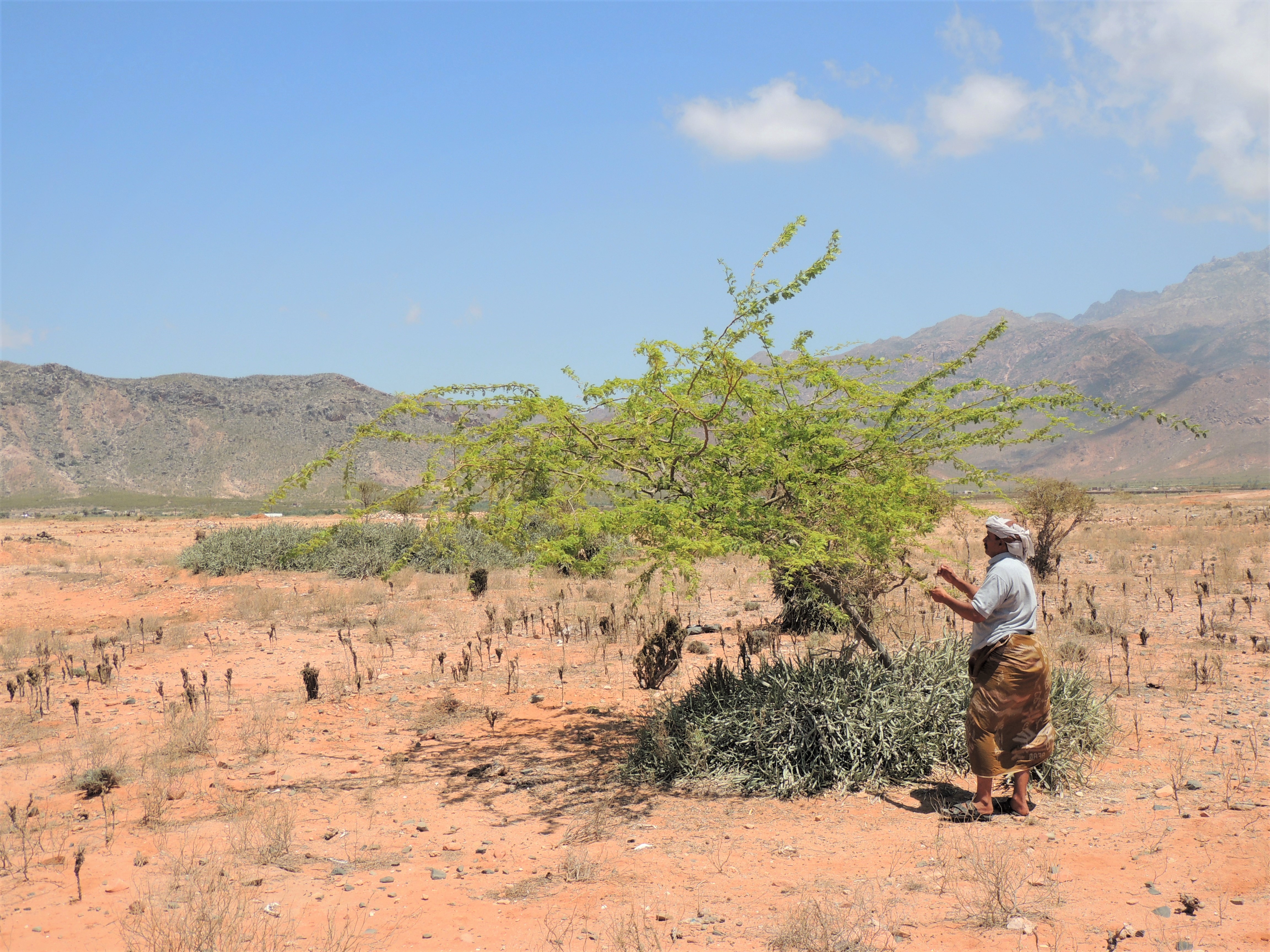
Bushera Ahmed Abdulla is able to identify and remove tiny prosopis seedlings before the invasive plant can take root.
In this photo special we turn the spotlight on members of the community in the Socotra Archipelago, Yemen – including Bushera Ahmed Abdulla pictured above – who are working together with invasive species experts from CABI to help rid the region of devastating Invasive Alien Species (IAS) including common pest pear Opuntia stricta and prosopis.
Dr Arne Witt, CABI’s Coordinator: Invasive Species, is providing guidance to the local UNEP/GEF team and in extension to the Environmental Protection Authority (Socotra branch), the Socotra Office for Agriculture, the Hadiboh District and the Socotra Governorate, in the implementation of a cactus eradication programme on the continental island group – designated a UNESCO Natural World Heritage site in 2008.
The ongoing project, entitled ‘Support to the Integrated Program for the Conservation and Sustainable Development of the Socotra Archipelago’, is funded by the Global Environment Facility and is being implemented by UN Environment and executed by the Senckenberg Society for Nature Research (Germany) working together with CABI and the Ministry of Water and Environment (Yemen) and the Environmental Protection Authority (Socotra Branch).

The endemic dragon blood tree will come under threat if invasive species are not managed.
Mr Uwe Zajonz, coordinating from Senckenberg, states that this project is addressing, among others, invasive species, sustainable land-use management, biodiversity conservation, and protected areas to further strengthen efforts to protect Socotra’s unique flora and fauna.
Dr Witt said, “Around 37% of the plants found on Socotra occur nowhere else in the world – there are also 30 endemic vertebrate species, etc. So it’s a very special place.
“As part of the GEF project we are trying to protect it from IAS, including prosopis and cactus. Prosopis and cactus have established but thanks to a surveillance programme, run by our local expert Ahmed Sulieman, we identified new invasions early enough to initiate an eradication campaign.
“Based on information provided by islanders we found prosopis and cactus in the village of Kam. Following an intensive awareness campaign involving all villagers, including children, the offensive plants were all removed.”

Ahmed Saeed Suleiman uses his training in IAS management to deal with the noxious weed.
Dr Witt added that everyone in the locality, including Bushera, have taken responsibility for tackling IAS as best they can.
“Bushera has very much been involved in the eradication process.” Dr Witt said, “She has managed to identify tiny prosopis seedlings which none of us could see. Now that the mother plants have been removed eradication can only be confirmed once the seedbank has been depleted.”

Mr Suleiman gets to grips with the scourge of prosopis on Socotra.
Dr Witt said that without Bushera’s help to task of fighting prosopis would be ‘considerably more difficult’.
“The reward for Bushera? She wants to help in ensuring that her village is not engulfed by this noxious weed. Maybe she will be the next Socotrian invasion biologist.”
Additional information
Photographs
A range of photographs are available to download from CABI’s Dropbox account here (photos by UNEP/GEF Socotra team, July 2018): https://www.dropbox.com/sh/2v32whr3zj0hz90/AACzQPMXQRdkALb7akx7c9zHa?dl=0
Other relevant projects/research
Read more about controlling ‘pest pear’ in Laikipia, Kenya here: https://www.cabi.org/projects/project/44986
See the news story ‘Sap-sucking insects save livelihoods in Kenya’ here: https://www.cabi.org/news-and-media/2015/sap-sucking-insects-save-livelihoods-in-kenya/
Watch the video ‘Green Invasion – Destroying Livelihoods in Africa’ here: https://www.cabi.org/news-and-media/2014/cabi-produces-new-video-on-invasive-weeds-in-africa/
1 Comment
Leave a Reply
Related News & Blogs
Bursary improves cross-CABI collaboration for more effective international development work
CABI bursary: seconded Mariya Iqbal and Gareth Dicks from CABI UK with CABI knowledge tool users from the Chinese Academy of Agricultural Sciences and the MARA-CABI Joint Laboratory for Biosafety in Beijing. A strength of CABI is its work on a global s…
30 September 2019





Reblogged this on The Invasives Blog.